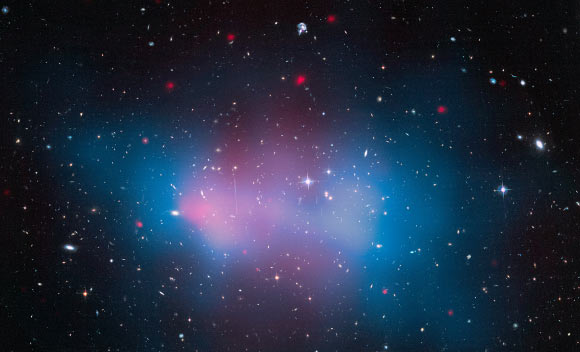Astronomers using NASA’s Hubble Space Telescope have weighed the El Gordo Galaxy Cluster – the largest known galaxy cluster in the distant Universe.

This composite image shows the galaxy cluster ACT-CL J0102-4915, also known as the El Gordo Galaxy Cluster, the most massive cluster of galaxies ever seen to exist when the Universe was just half of its current age of 13.8 billion years. Image credit: NASA / ESA / J. Jee, University of California, Davis / J. Hughes, Rutgers University / F. Menanteau, Rutgers University and University of Illinois, Urbana-Champaign / C. Sifon, Leiden Observatory / R. Mandelbum, Carnegie Mellon University / L. Barrientos, Universidad Catolica de Chile / K. Ng, University of California, Davis.
The El Gordo Galaxy Cluster, officially catalogued as ACT-CL J0102-4915, contains several hundred galaxies swarming around under a collective gravitational pull. The cluster may be so huge because it is the result of a titanic collision and merger between two separate galaxy clusters.
By precisely measuring how much the gravity from the cluster’s mass warps images of far-more-distant background galaxies, Dr James Jee from the University of California at Davis and his colleagues have calculated the cluster’s mass to be as much as 3 million billion times the mass of our Sun.
The Hubble data show that the cluster is roughly 43 percent more massive than earlier estimates based on X-ray and dynamical studies.
“It’s given us an even stronger probability that this is really an amazing system very early in the Universe,” said Dr Jee, who is the lead author of the paper published in the Astrophysical Journal (arXiv.org version).
A fraction of this mass is locked up in several hundred galaxies that inhabit the El Gordo Galaxy Cluster and a larger fraction is in hot gas that fills the entire volume of the cluster.
The rest is tied up in dark matter, an invisible form of matter that makes up the bulk of the mass of the Universe.
Though galaxy clusters as massive are found in the nearby Universe, such as the so-called Bullet Cluster, nothing like this has ever been seen to exist so far back in time, when the Universe was roughly half of its current age of 13.8 billion years.
Dr Jee and his colleagues suspect such monsters are rare in the early Universe, based on current cosmological models.
The immense size of the cluster was first reported in January 2012.
Astronomers estimated its huge mass based on observations from NASA’s Chandra X-ray Observatory and ESO’s Very Large Telescope. They were able to put together estimates of the cluster’s mass based on the motions of the galaxies moving inside the cluster and the very high temperatures of the hot gas between the cluster galaxies. The challenge was that they noticed that the cluster looked as if it might have been the result of a titanic collision between a pair of galaxy clusters the astronomers describe as ‘seeing two cannonballs hit each other.’
“We wondered what happens when you catch a cluster in the midst of a major merger and how the merger process influences both the X-ray gas and the motion of the galaxies. So the bottom line is that because of the complicated merger state, it left some questions about the reliability of the mass estimates we were making,” said study second author Dr John Hughes from Rutgers University.
Co-author Dr Felipe Menanteau from the University of Illinois at Urbana-Champaign added: “that’s where the Hubble data came in.”
“We were in dire need for an independent and more robust mass estimate given how extreme this cluster is and how rare its existence is in the current cosmological model. There was all this kinematic energy that could be unaccounted for and could potentially suggest that we were actually underestimating the mass.”
The expectation of ‘unaccounted energy’ comes from the fact that the merger is occurring tangentially to the observers’ line of sight. This means they are potentially missing a good fraction of the kinetic energy of the merger because their spectroscopic measurements only track the radial speeds of the galaxies.
The astronomers used Hubble to measure how strongly the mass of the cluster warped space. Hubble’s high resolution allowed measurements of so-called ‘weak lensing,’ where the cluster’s immense gravity subtly distorts space like a funhouse mirror and warps images of background galaxies. The greater the warping, the more mass is locked up in the cluster.
______
M. James Jee et al. 2014. Weighing “El Gordo” with a Precision Scale: Hubble Space Telescope Weak-lensing Analysis of the Merging Galaxy Cluster ACT-CL J0102–4915 at z = 0.87. ApJ 785, 20; doi: 10.1088/0004-637X/785/1/20







